#The Mekons
Text

The Mekons, 1982.
“The Mekons are the most revolutionary group in the history of rock ‘n’ roll.” — Lester Bangs.
70 notes
·
View notes
Audio
Mekons - Sympathy for the Mekons (1987)
Self mythologizing (here a la the Stones) has always been a part of the Mekons thing. That and frequent mentions of the devil. This song has got it in spades.
History has a stutter
It says w...w...w...watch out!
21 notes
·
View notes
Text

No one's making any noise now, sshhh
We've been waiting for so long
They took away our films and tapes and notebooks
But it's okay, we've self-censored this song
But these lines are all individuals
And there's no such thing as a song
And even the silent are now guilty in the (empire of the senseless)
What's your line of questioning, sir?
I can't interrupt intercept a one word sentence
Invent a war in secrecy
Sliding scenery like a vintage toy
Isn't plastic surgery wonderful?
Satellite secret national security
(Empire of the senseless)
Turning journalists into heroes takes some doing
Boring Ollie north down in the subway dealing drugs and guns
(Empire of the senseless)
Turning little liars into heroes, it's what they've always done
This song promotes homosexuality
It's in a pretended family relationship with the others on this record
And on the charts and on the jukebox
And in the radio
And in the radio
No one's making any noise now, sshhh
Stay quiet
All unacceptable gropings have been removed from the screen
Only eyes full of unspeakable thoughts remain
And even the silent are now guilty in the (empire of the senseless)
Baked beans, sugar, and margarine
Bread, jam, groceries, and lard
For the unsentimental
The men who like the lady hard
The men who like the hard lady
And you know that people are really rather afraid
(Empire of the senseless)
Afraid of being swamped
Afraid of being swamped by selfishness and greed
(Empire of the senseless)
(Empire of the senseless)
(Empire of the senseless)
(Empire of the senseless)
(Empire of the senseless)
Source: LyricFind
Songwriters: Jon Langford / Tom Greenhalgh
Empire of the Senseless lyrics © Low Noise America Music
#the mekons#mekons#jon langford#sally timms#records#vinyl#my record collection#Spotify#an old favorite#1980s
8 notes
·
View notes
Text

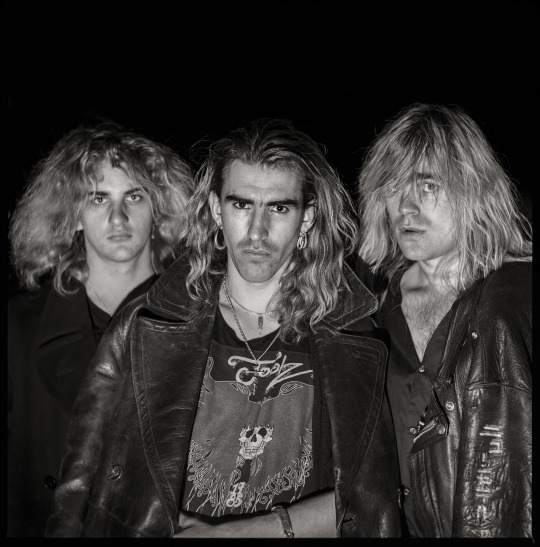





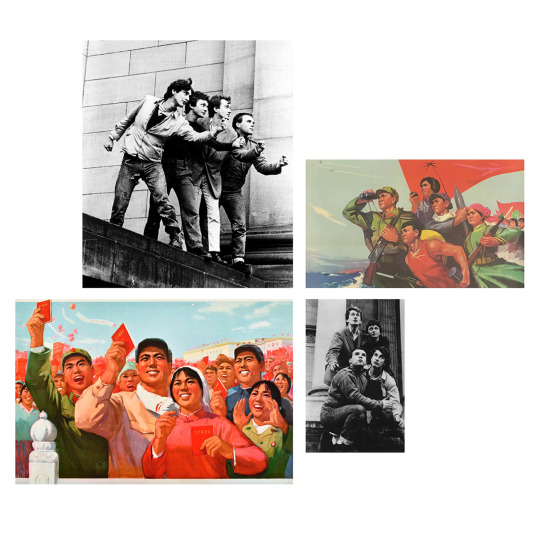
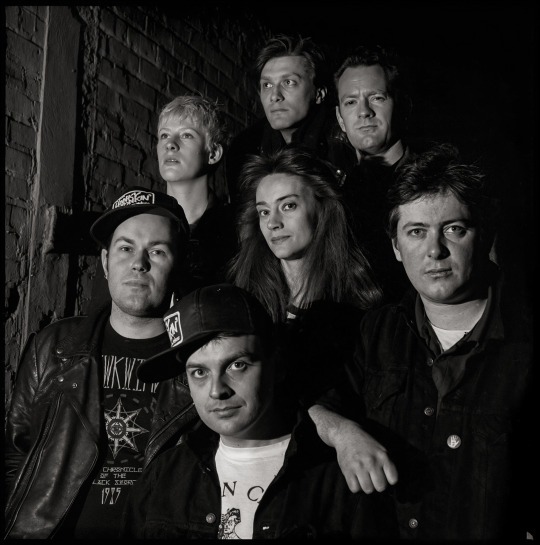
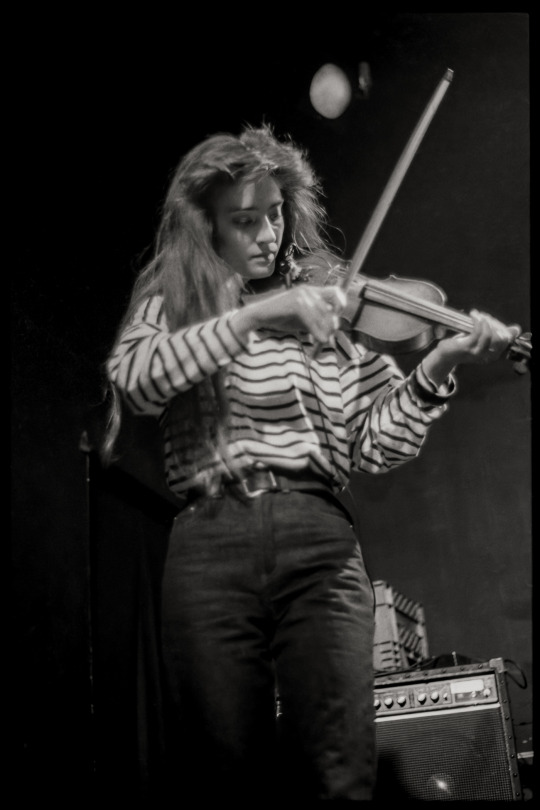



NEW MODEL ARMY and THE MEKONS, 1986 and 1987
Buying a flash - a Vivitar 285hv, to be precise, purchased at B&H in New York City - made working in dark clubs easier, and in the early years of my career most of my shooting involved bands like New Model Army from Bradford, who I photographed in December of 1986, after they had finally received visas to tour in the US after being previously denied one for having "no artistic merit". I was a fan of their album No Rest for the Wicked, so I interviewed and photographed them for Nerve magazine. Bandleader Justin Sullivan, who had just stopped using the alias "Slade the Leveller" - adopted so he could keep getting unemployment benefits while making money playing music - was thoughtful and sincere, and the band showed a sense of humour that belied their somber image when I pulled out some of the little rubber faces I used in my portrait of director John Waters.
My shoot with New Model Army was done quickly after soundcheck at RPM, the cavernous club on Toronto's waterfront where they were playing, and turned out better than I had expected. My interview with Justin Sullivan, the band's leader, was ultimately less successful: he had been candid and forthright with me, but I did him dirty when I wrote a more than slightly sarcastic piece, mocking him for his admiration of Bruce Springsteen, for instance. (Every young rock critic wants to appear hipper than their subjects, sad to admit.) I didn't think much of it until months later when the paper I wrote for received a letter from the poet and artist Joolz Denby (aka Julianne Mumford), a frequent collaborator of Sullivan's. (He's wearing one of her t-shirts in my photos.) Very graciously she told me that, while Sullivan was unlikely to have admitted it, he was hurt by my tone in the article. She went on to talk about their West Yorkshire hometown in a couple of beautifully descriptive paragraphs as a way of explaining the context of what Sullivan and the band were doing, and by the time I finished reading her letter I felt quite chastened and ashamed of myself.
New Model Army still perform and tour, though drummer Rob Heaton died of cancer in 2004. A film about the band, Between Dog and Wolf: The New Model Army Story, was released in 2014.
Another band I photographed in my early days was The Mekons, shot in the alleyway behind Lee's Palace, one of Toronto's most venerable rock clubs, after I'd finally bought a light stand and umbrella for my Vivitar flash. The band dated back to the first wave of punk in the UK with their proudly inept first single "Never Been in a Riot" (a subtly wry response to the Clash's "White Riot"), but they'd recently reformed playing an idiosyncratic and literate version of country punk with albums like Fear and Whiskey and The Edge of the World. They provided me with an excuse to like country music, and I was excited to photograph them for a story for Nerve magazine. Shooting large bands (any band, really) is always a challenge, and I didn't win them all over at first when I explained that my initial inspiration for the shoot was Chinese and Soviet "socialist realism" heroic propaganda art, filtered through an old photos of their colleagues from Leeds, the Gang of Four, that I'd always loved.
They said they were familiar with the photos - the photographer, Andrew Corrigan, had been an original member of the band, though I didn't know this at the time - but didn't express much enthusiasm for the idea. (Singer and guitarist Jon Langford mumbled something about "not feeling very socialist realist.") Still, they played along for a few frames at least, and I was able to get one workable photo, along with a more conventional shot of the group standing on the metal fire escape behind the club. As I always did back then, I photographed the band live as a backup in case my portraits didn't work out, but thankfully I was able to provide the magazine with at least one passable photo.
Like New Model Army, the Mekons still perform, and were the subject of a 2013 documentary, Revenge of the Mekons.
#new model army#the mekons#band photography#portrait#portrait photography#photography#film photography#musician#rock band#early work#mamiya c330#joolz
3 notes
·
View notes
Text
The Mekons - Vengeance
youtube

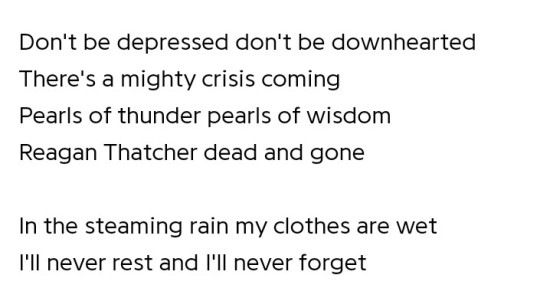
#the mekons#vengeance#jon langford#tom greenhalgh#sally timms#susie honeyman#dick taylor#brendan croker#john gill#ken des esseintes#rico christian#steve goulding#folk punk#punk#punk rock#so good it hurts#1985#Youtube
3 notes
·
View notes
Link
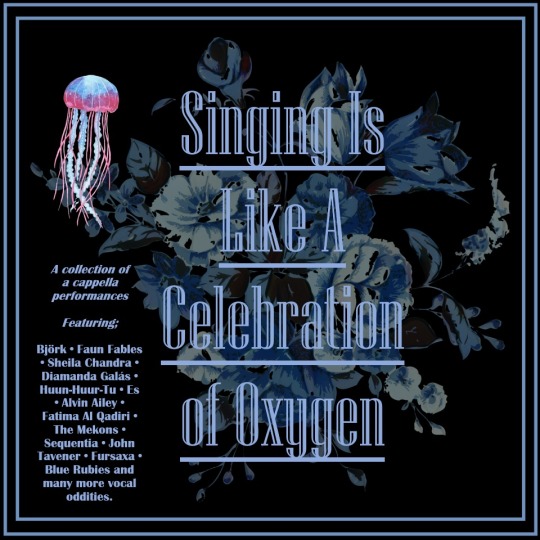
A primitive mix of largely a cappella recordings and other vocal oddities, all stitched together in a very simple way. It’s hopefully entertaining and challenging in equal measure, and something that I hope summons joy, fear, sadness and laughter!
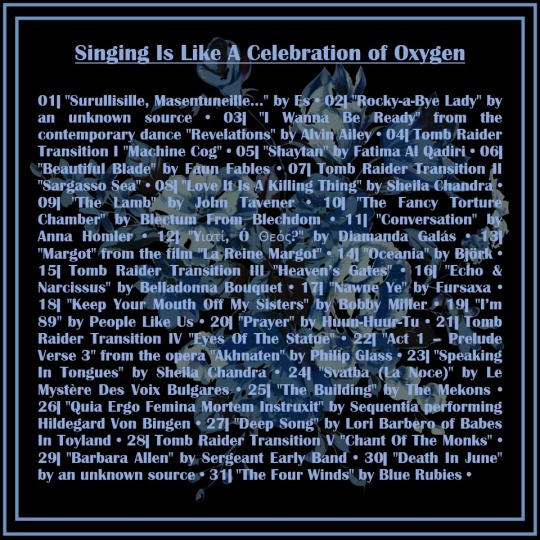
#a cappella#vocals#folk#avant garde#spoken word#classical#spoken poetry#bjork#Faun Fables#diamanda galas#john tavener#fatima al qadiri#sheila chandra#people like us#Le Mystère Des Voix Bulgares#the mekons#huun-huur-tu#Fursaxa#sequentia
2 notes
·
View notes
Text

THE MEKONS
4 notes
·
View notes
Text
Jon Langford Interview: Serve the Song
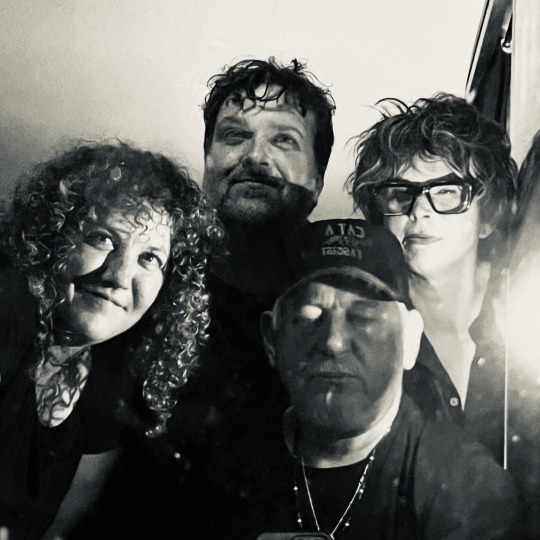
BY JORDAN MAINZER
When you ask Jon Langford what he's up to in the near future, he'll likely list a few upcoming concerts and art exhibitions before you realize he's referring to just this upcoming weekend. For the singer-songwriter and painter, the Mekon and Waco Brother, his past, present, and future discography and levels of participation seem just as vast. During his most recent visit to Austin (of which SXSW was a mere part), Langford played twelve shows: four with The Waco Brothers, three with The Far Forlon (his Austin-based band that plays Langford solo and Mekons songs), and five with The Bright Shiners, his new band that just released their debut record, Where It Really Starts (Tiny Global Productions). But Langford views himself as a mere thread rather than the center. "I am lucky to get to work with people more talented than me," he said to me over the phone after returning from SXSW. Sarcasm aside, Where It Really Starts epitomizes that democratic approach. "I love having not all of the responsibility on myself to come up with stuff," Langford said. "It's not a solo album. It's better than that."
The Bright Shiners started when Langford and John Szymanski, his frequent musical partner, attempted to make a duo acoustic guitar record that resulted in some interesting tunes, but not enough to resist contacting singer and keyboard player Alice Spencer. That is, though the Austin-based Spencer played in soul-funk band Shinyribs, Langford and Szymanski were enraptured by her solo work and Mellotron playing. Spencer was on board, and then Langford and Szymanski brought in violinist Tamineh Gueramy. The four wrote the majority of the songs on Where It Really Starts, with Langford concocting first drafts, Spencer arranging, and the group taking them to fruition. The result is easily the most lush music of Langford's career, from the steadily chiming "For The Queen of Hearts" to the dulcet "I Have A Wish".

Where It Really Starts is rich without being overstuffed, a natural combination of layered guitars and vocal harmonies, piano, pedal-affected strings, looped percussion, and of course, Mellotron. In other words, it's folk music with contemporary touches, Langford's storytelling firmly in the present while sometimes sounding appropriately old-timey. His vocal delivery resembles that of a troubadour on the fluttery, swaying "Awake The Land Of The Shadows"; he passionately trills on "Seahouses". And on "Discarded", a duet with Spencer, the two finish each other's sentences like a sardonic country couple. "You can talk about love, you can talk about society," sings Langford, "But when push comes to shove, you wiped the floor with me," responds Spencer, atop brawny, off-kilter horns. "Seahouses" and "Discarded", specifically, contain a multitude of musical ideas Spencer brought to the table, the former's filmic feel and the latter's horns. And even producer Brian Beattie gets his kicks: The album's final track, which sounds like an outtake from or demo of "Discarded", was actually Beattie playing all of the instruments in the studio and recording his half-hearted attempt at the lyrics of "Discarded", which The Bright Shiners found so funny, they decided to put it on the album.
My interview with Langford was not set up through a publicist. I literally said hello to him when I ran into him at The Beer Temple, at which point he mentioned he had a new record coming out that he'd be down to talk about. Two weeks later, we spoke on the phone. He and The Bright Shiners signed a two-album deal with Tiny Global Productions, so you can expect to hear more, but who knows what else--spontaneous or otherwise--Langford will get up to. In the meantime, read our interview below, edited for length and clarity.

Since I Left You: When did The Bright Shiners form, and when did you start writing Where It Really Starts?
Jon Langford: It was more a social thing. We were talking. Alice Spencer was in a band...she's a keyboard player and a very good technical singer. She was doing other solo stuff which was really fascinating. She has a jazz background, but isn't into that virtuoso jazz stuff. We decided to write a few songs with John Szymanski and Tamineh [Gueramy.] John [had] been working with me, and I said to him [about Alice], "This woman's playing a Mellotron." And he said, "We should form a band with her." I didn't know there was such a thing as digital Mellotron. It's really kind of fascinating to me. Most of the songs are co-writes by the whole band. But I was handing over sketches and [Alice] was turning them into fully realized arrangements with vocals.
SILY: Did you come up with the lyrics?
JL: All the lyrics are mine.
SILY: How did you finish the songs? Was that a group effort?
JL: Yeah, the arrangements and the songs. The guy who produced it with us, [Brian Beattie,] had been working with Alice a lot. They'd done a duo together. The studio is called The Wonder Chamber. Alice was doing some recording there and sent me some video. I said, "Where is this? This is fantastic! If we do anything, this is where we should do it."
SILY: Is it in Austin?
JL: Yeah.
SILY: It seems to me that this album, more than your other solo albums, exists in the folk tradition but with more contemporary touches. Maybe that's the digital Mellotron. Would you agree?
JL: Yeah. We just wanted it to be kind of minimal. We started off with acoustic guitars, because John and I had been doing that for quite a while in a duo. We tried to make a record just me and him with acoustic guitar. It was alright, and we had a few ideas, but that's kind of on the backburner.
Music is so inherently collaborative. I've had solo records where I was totally in charge. This is basically something else. The song "Seahouses" was this epic thing Alice came up with based on something I'd sent her. I thought, "I don't remember writing this." It was mind-blowing. So beautiful, so different.
SILY: It definitely is a song that sounds like the seaside.
JL: There's something cinematic about it. I want to bash things down as simply and plainly as possible. That one has some epic moments. It's minimal in the sense that it's not a jam band. It's more like a dub reggae record where you have parts that lock and drive the song along and serve the record. When there's no singing, the parts get kind of detached from it. You can listen to these individual parts. It's getting away from the virtuosity and soloing: Just trying to serve the song.

SILY: Was there anything different this time around that inspired your lyrics?
JL: That's a good question. I'll have to talk to my therapist about that. [laughs] The lyrics are quite personal. They are inspired by the visual art I do. "For The Queen of Hearts", there was a painting called The Queen of Hearts that I made, a country singer that's like a playing card, body on top and repeated underneath. She's got two heads and is singing. The other one is a skull. I thought the song was kind of based on that.
SILY: Are you contextualizing each song with paintings you've done that might have inspired them?
JL: Some of them. "Seahouses", I went to a place called "Seahouses". It's a really dramatic place in the north of England, kind of bleak, pebbles rolling and smashing against each other, permanent and impermanent at the same time. The transitory nature of life and time itself, or something. It sounds really bonkers when I say it like that. [laughs]
Each song, I guess, has its own life. There's a lot of visual stuff in them.
SILY: There seems to be a good mix of songs that are reflective or internal and others more about storytelling, such as "Tell Me Your Story".
JL: I wrote that with a friend in Chicago, Jenny Bienemann. She had a project where she would write haikus and would hand them out to [people] to write a song from it to perform in a concert. There were 15 haikus, and she said, "Pick one you like." I thought "Tell Me Your Story" was fantastic. When you meet someone, you want to find out everything about them.
SILY: When you write or listen to folk music, do you tend to draw parallels between the modern day and the past?
JL: I think I write pretty much in the present. I'm not writing nostalgic or particularly optimistic [songs] anymore. I've tried to temper realism or pessimism.
SILY: A song like "The Emperor's Fiddle", with lines about talking to the dead and necromancing, and a line like, "We have more guns and disease than you can ever use" sounds like something that could be from an old folk song, but you could apply it to the modern day.
JL: You can apply it to the modern day. It's about going up the river and selling the Natives whiskey.
SILY: Why did you choose to throw in an unlisted track at the end that's basically an outtake of "Discarded"?
JL: That's actually Brian Beattie setting up the studio before we even arrived and playing all the instruments himself. [laughs] The first time I sat in the studio properly, he played me that. [laughs] I could have walked out. "Are you taking the piss? Are you making fun of us?" We all find it really amusing. "Is it you...I?" It grew on me in the end. I was like, "It's gotta go on."
SILY: It's like when people leave in studio chatter, but taken to the extreme.
JL: It exists. I don't know what else we were gonna do with it. Put it in a box and bury it somewhere? [laughs]

SILY: Did you do the album art for this?
JL: It's a collaboration between me and Jim Sherraden, the master printer at Hatch Show Print in Nashville. It's his woodcuts and my central figures.
SILY: How does it relate to the story of the album?
JL: It's parallel. I started working with him when we started The Bright Shiners. It was work that I was making. The idea of two people with a guitar flying through the air. There's an ethereal nature to a lot of these songs that ties in quite nicely. I like the idea of the printmaking. It's ornate. I like repetition. Mark E. Smith said, "It's not repetition, it's discipline." I find that in a lot of music I like. There doesn't have to be a high point or piano solo for people to show off their virtuosity. I thought that was a good parallel to the album. It can be beautiful and serious, but it doesn't have to be.
SILY: You can apply what Mark E. Smith says to listening, to, especially more repetitious songs that take a level of discipline or commitment, especially when they have abstraction to it.
JL: This is sort of artistic conceit. It wasn't just folk songs. We were definitely thinking about robotic, repetitive things going on. Some sort of hypnotic thing. "A Scale of One to Nine", I just wanted to [write a song] that sounds good when it comes back. [laughs] It's really relentless.
SILY: Any time you include wordless harmonies, it wriggles its way into your head.
JL: I don't like when people ask if I've made a concept record. Every record's a concept record to me. It's not like I've made a rock opera. It's a definable narrative. There's a story.
SILY: For how long have you been playing these songs live?
JL: [For] probably about eight months. After playing [at first], we understood what we wanted, and the writing process became a lot easier. We didn't do a whole album in one sitting, it was about four sittings, a few songs each time, and we got better at working. The song "I Have a Wish" is completely live. We wanted to see what it was like all playing together. It was really beautiful. We knew what we wanted to do. It's a simple song.
SILY: It has a really nice lilting melody.
JL: Alice is a really good singer. Most of the songs are duets. She really listens to phrasing and writes harmonies over the top. A lot of the time she's doing quite odd harmonies that are kind of cool.
SILY: How was it adapting some of the other songs to a live performance?
JL: It was pretty easy with this. We don't try making it sound exactly like the record. We did some gigs with a bass player and percussionist last year. Economically, we can't really do [that all the time]. We need to make it work as a four-piece. John and I have an understanding, telepathically, if I go up the neck, he goes down. The snare drum is often playing more percussively than he is, and he's finding notes that are similar to what's on the record but not exactly. Everybody sings really well, as well. We all sing together. There are beautiful moments. Tamineh uses pedals for the violin, and there are a lot of violin effects she's using. She'll use them in place of electric guitar on the record. Some Mellotron sounds are pretty fantastic. The violin with pedal delays can sound like a whole orchestra.
SILY: Did you put horns on "Discarded"?
JL: We did. Alice wanted to put a Salvation Army [brass] band on a track. I wasn't there when she did it. She got some people from Austin. I mirrored the part she was playing on the Mellotron and made it into something bigger. I wasn't sure about that song.
SILY: Are you always writing songs?
JL: Yep. I haven't for a while. I think when we finished the album, I definitely went through, at the end of last year, a phase where I wasn't doing anything. It's like a muscle. Once you turn it on again, it's like a tap. If you're not writing, you are writing somewhere in your head. A lot of things in the songs seem strange to me now because I didn't know what I meant when I wrote them, but sometimes, when we sing them on stage, I go, "Bloody hell, I wonder whether that's what that means." [laughs] It's kind of revealing tapping into the subconscious. That's where a lot of the stuff gets written.
SILY: Do you find it the same when someone in the audience might ask what something means or say a song means something different to them? Do the songs then change meaning for you?
JL: I kind of like the limitations of being a songwriter in the sense you can try and communicate something, but it might be misconstrued. I think that brings responsibility to what you talk about. It's so boring to set up a message, and say, "This song is about." It's a delicate balance to start writing songs and not be pedantic but still be authentic. Hopefully, people think about what you're singing about.
SILY: Is there anything you've been listening to, watching, or reading lately that's caught your attention?
JL: I listen to a lot of reggae still, but it's not new. I've got a vinyl player in my painting studio. I like that it stops every 25 minutes and you have to go and choose something else. You can't just put on a playlist. A lot of British reggae music from the 70s and 80s which wasn't appreciated at the time but is pretty fucking great. Steel Pulse, Misty in Roots. Bands I saw and played with at the time.
#interviews#jon langford#tiny global productions#john szymanski#alice spencer#tamineh gueramy#the beer temple#jenny bienemann#hatch show print#where it really starts#the mekons#the waco brothers#sxsw#the far forlorn#shinyribs#brian beattie#the bright shiners#the wonder chamber#the queen of hearts#jim sherraden#mark e. smith#salvation army#steel pulse#misty in roots
0 notes
Text
youtube
0 notes
Text
youtube
An unsung band in my humble estimation. The Mekons are always edgy, fun, rocking and smart. Love this song.
SONG OF THE DAY - Friday, November 24, 2023
1 note
·
View note
Text
youtube
The Mekons - "Born To Choose"
8 notes
·
View notes
Text
youtube
The Mekons - Heart And Soul
#the mekons#heart and soul#jon langford#tom greenhalgh#kevin lycett#chalkie white#ros allen#punk#punk rock#never been in a riot#7'' ep#1978#Youtube
4 notes
·
View notes
Text
If you can forget how to ride a bike / Well, you've had a good teacher
--Will Oldham / Palace Bros., "For the Mekons et al."
0 notes
